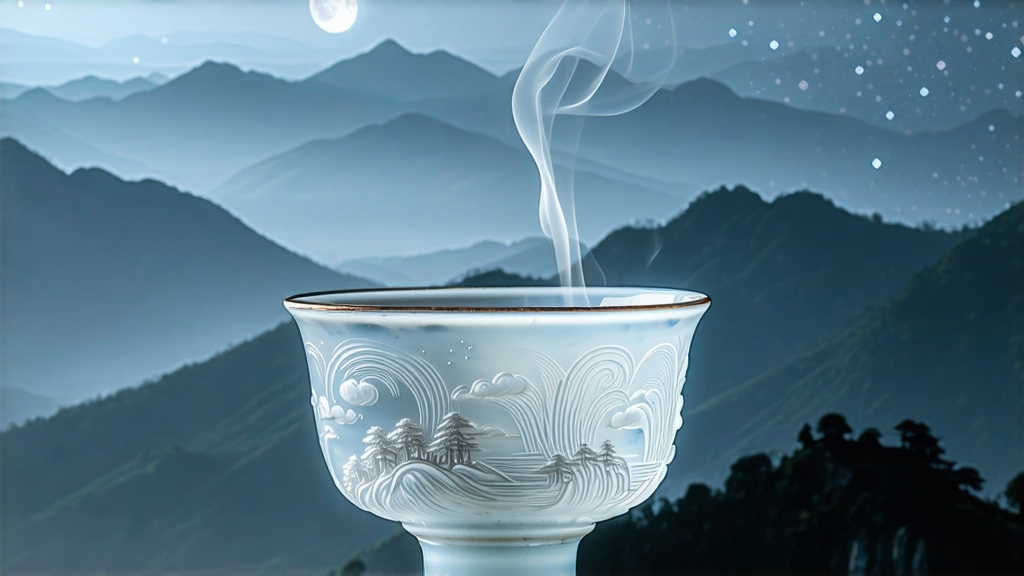
Tucked high on the forested ridges of southern Yunnan, where the Mekong bends like liquid jade and night mists rise to meet the moon, a tea unlike any other quietly turns from green to silver. International drinkers may know Bai Hao Yin Zhen from Fujian, yet few have tasted Yue Guang Bai—“Moonlight White”—a variety that belongs to the white-tea family but carries the genes of ancient Yunnan big-leaf tea trees. Its story, processing logic, and even the way it catches light in the cup make it a living bridge between the minimalist white-tea aesthetic and the deep, resinous soul of pu-erh country.
Historical whispers
White tea as a category was first documented in the Song dynasty, yet Yunnan’s version is barely thirty years old. Local legend says a tea master was inspired by the sight of fresh buds glowing under a full moon at 2 000 m elevation. He decided to wither the harvest without direct sun, letting lunar radiation and mountain breeze do the slow work of oxidation. Whether myth or marketing, the name stuck, and Moonlight White entered the lexicon of boutique tea in the early 1990s. Because the leaves come from Camellia sinensis var. assamica rather than the small-leaf Fujian cultivar, the tea inherited the heft, malt, and aging potential of its pu-erh cousins while still qualifying, by virtue of minimal fixing and rolling, as a white tea.
From forest to flake
The picking window is brutally short: only two misty weeks after the Qingming festival, when the apical bud and the first two leaves reach a silvery-green equilibrium. Workers cycle up switchbacks at dawn, cutting each shoot with a curved “bird-beak” knife to avoid bruising. The harvest is then laid on raised bamboo trays inside ventilated sheds open to the night sky; no sun, no machine blast—just a 48-hour lunar wither that drops moisture to 40 %. A further 12-hour “resting pile” allows enzymatic browning at the leaf edge, creating the signature crescent of dark ochre against ivory. Finally, a 30-minute low-temperature bake at 45 °C locks in the fragrance without caramelizing sugars. The result is a leaf that looks like a tarnished silver ingot: one side downy white, the other ash-black, as though permanently caught in an eclipse.
Craft subtleties
Unlike Fujian white teas, Moonlight White is never kneaded; pressure would rupture the thick Yunnan cell walls and release astringent polyphenols too quickly. The absence of rolling also preserves the hollow needle shape, allowing interior volatiles—linalool, geraniol, and a rare jasmine lactone—to survive months of storage. Producers in Jinggu and Lincang now experiment with “moon-withering tunnels,” black-net greenhouses that simulate starlight by blocking UV-B while permitting infrared, but purists still swear by open-air sheds where the only light comes from constellations and fireflies.
How to brew it without breaking its heart
Moonlight White is forgiving, yet rewards precision. Start with 4 g for a 150 ml vessel; porcelain gaiwan or a thin-walled glass teapot both work, but avoid zisha clay whose porosity will muffle the high florals. Use 85 °C water—any hotter scalds the down, any cooler fails to lift the resinous base. The first infusion should be a 15-second “awakening” pour, discarded by some and sipped by others for its faint ozone note. Subsequent steeps lengthen in arithmetic progression: 25 s, 35 s, 50 s, 70 s, 90 s. You will coax five clean infusions before the leaf begins to fray, though cold-brewing overnight at 4 °C can stretch the arc to twelve luminous cups. Observe the color: not the pale champagne of Yin Zhen, but a deeper topaz that flashes moonlit silver at the rim.
Tasting the night
Bring the cup to lip level and pause; aroma rises in three waves. First comes white peach and fresh alfalfa, a signature of assamica buds. Within seconds the mid-wave arrives: honeyed cucumber and the scent of rain on hot granite. Finally, a low, steady note of pine resin and cacao husk anchors the experience, a reminder that these trees once shaded wild cardamom and cinnamon. On the palate the liquor is weight